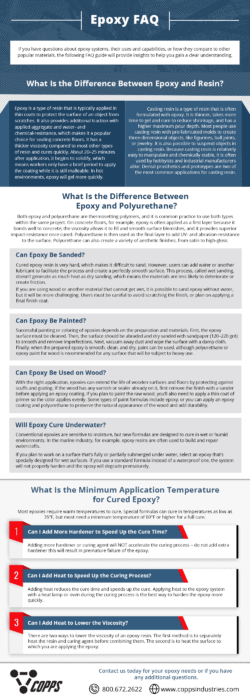If you have questions about epoxy systems, their uses and capabilities, or how they compare to other popular materials, the following FAQ guide will provide insights to help you gain a clear understanding.
What Is the Difference Between Epoxy and Resin?
Epoxy is a type of resin that is typically applied in thin coats to protect the surface of an object from scratches. It also provides additional traction with applied aggregate and water- and chemical-resistance, which makes it a popular choice for sealing concrete floors. It has a thicker viscosity compared to most other types of resin and cures quickly. About 20–25 minutes after application, it begins to solidify, which means workers only have a brief period to apply the coating while it is still malleable. In hot environments, epoxy will gel more quickly.
Casting resin is a type of resin that is often formulated with epoxy. It is thinner, takes more time to gel and cure to reduce shrinkage, and has a higher maximum pour depth. Most people use casting resin with pre-fabricated molds to create three-dimensional objects, like figurines, ball joints, or jewelry. It is also possible to suspend objects in casting resin. Because casting resin is relatively easy to manipulate and chemically stable, it is often used by hobbyists and industrial manufacturers alike. Dental prosthetics and prototypes are two of the most common applications for casting resin.
What Is the Difference Between Epoxy and Polyurethane?
Both epoxy and polyurethane are thermosetting polymers, and it is common practice to use both types within the same project. On concrete floors, for example, epoxy is often applied as a first layer because it bonds well to concrete; the viscosity allows it to fill and smooth surface blemishes, and it provides superior impact-resistance once cured. Polyurethane is then used as the final layer to add UV- and abrasion-resistance to the surface. Polyurethane can also create a variety of aesthetic finishes, from satin to high-gloss.
Can Epoxy Be Sanded?
Cured epoxy resin is very hard, which makes it difficult to sand. However, users can add water or another lubricant to facilitate the process and create a perfectly smooth surface. This process, called wet sanding, doesn’t generate as much heat as dry sanding, which means the materials are less likely to deteriorate or create friction.
If you are using wood or another material that cannot get wet, it is possible to sand epoxy without water, but it will be more challenging. Users must be careful to avoid scratching the finish, or plan on applying a final finish coat.
Can Epoxy Be Painted?
Successful painting or coloring of epoxies depends on the preparation and materials. First, the epoxy surface must be cleaned. Then, the surface should be abraded and dry sanded with sandpaper (120–220 grit) to smooth and remove imperfections. Next, vacuum away dust and wipe the surface with a damp cloth. Finally, when the prepared epoxy is smooth, clean, and dry, paint can be used, although polyurethane or epoxy paint for wood is recommended for any surface that will be subject to heavy use.
Can Epoxy Be Used on Wood?
With the right application, epoxies can extend the life of wooden surfaces and floors by protecting against scuffs and grating. If the wood has any varnish or sealer already on it, first remove the finish with a sander before applying an epoxy coating. If you plan to paint the raw wood, you’ll also need to apply a thin coat of primer so the color applies evenly. Some types of paint formulas include epoxy, or you can apply an epoxy coating and polyurethane to preserve the natural appearance of the wood and add durability.
Will Epoxy Cure Underwater?
Conventional epoxies are sensitive to moisture, but new formulas are designed to cure in wet or humid environments. In the marine industry, for example, epoxy resins are often used to build and repair watercrafts.
If you plan to work on a surface that’s fully or partially submerged under water, select an epoxy that’s specially designed for wet surfaces. If you use a standard formula instead of a waterproof one, the system will not properly harden and the epoxy will degrade prematurely.
What Is the Minimum Application Temperature for Cured Epoxy?
Most epoxies require warm temperatures to cure. Special formulas can cure in temperatures as low as 35°F, but most need a minimum temperature of 60°F or higher for a full cure.
Can I Add More Hardener to Speed Up the Cure Time?
Adding more hardener or curing agent will NOT accelerate the curing process – do not add extra hardener this will result in premature failure of the epoxy.
Can I Add Heat to Speed Up the Curing Process?
Adding heat reduces the cure time and speeds up the cure. Applying heat to the epoxy system with a heat lamp or oven during the curing process is the best way to harden the epoxy more quickly.
Can I Add Heat to Lower the Viscosity?
There are two ways to lower the viscosity of an epoxy resin. The first method is to separately heat the resin and curing agent before combining them. The second is to heat the surface to which you are applying the epoxy.
Finding the Perfect Epoxy Solution
When your application requires an epoxy or epoxy resin system, Copps Industries is glad to help – our portfolio features over 2500 formulations, and we are also able to formulate a custom solution for your unique needs. We have over 40 years of experience creating epoxy products for a diverse range of industries, including the aggregate and mining and construction.
We also offer a private label manufacturing program.
Contact us today for your epoxy needs or if you have any additional questions.






